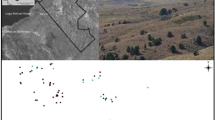Abstract
Several bivariate probability distributions, generated by different underlying dispersal mechanisms, are fitted to the observed frequencies of an isozyme marker gene using a maximum likelihood approach. The pollen dispersal data were generated using two experimental populations of meadow fescue (Festuca pratensis Huds.), homozygous for different allozymes at the (Pgi-2) locus, arranged in a circular donor–acceptor field design. The contribution of a plant depends on plant position, fecundity and flowering time, factors which are taken into account when fitting the different models. Several approximate likelihood-ratio tests are done between alternative nested models, and a wind threshold model with bimodality in the wind direction is selected. The evolutionarily important variances and expectations of gene displacement under the selected model are calculated. It is also shown that the underlying probability distribution is significantly more than exponentially leptokurtic. By fitting a distribution of deposition in all three dimensions to the data, taking into account differences in plant height, separate estimates of additional physical parameters are obtained, showing that gravity and vertical random movements are more important than intervening vegetation in limiting pollen dispersal in meadow fescue. According to the model, plants with a high seed yield contribute pollen over-proportionally to neighbouring plants.
Similar content being viewed by others
References
Adams, W.T. and Birkes, D.S. (1991) Estimating mating patterns in forest tree populations. In Biochemical Markers in the Population Genetics of Forest Trees (S. Fineschi, M.E. Malvolti, F. Cannata and H.H. Hattemer, eds), pp. 157–172. SPB Academic Publishing, The Hague.
Arnold, M.L., Robinson, J.J., Buckner, C.M. and Bennett, B. (1992) Pollen dispersal and interspecific gene flow in Lousiana irises. Heredity 68, 399–404.
Assuncão, R. and Jacobi, C.M. (1996) Optimal sampling design for studies of gene flow from a point source using marker genes or marked individuals. Evolution 50, 918–923.
Bateman, A.J. (1947a) Contamination of seed crops. II. Wind pollination. Heredity 1, 235–246.
Bateman, A.J. (1947b) Contamination of seed crops. I. Insect pollination. J. Genet. 48, 257–275.
Bateman, A.J. (1947c) Contamination in seed crops. III. Relation with isolation distance. Heredity 1, 303–336.
Bos, M., Harmens, H. and Vrieling, K. (1986) Gene flow in Plantago I. Gene flow and neighbourhood size in P. lanceolata. Heredity 56, 43–54.
Chaudhary, H.R., Jana, S. and Acharya, S.N. (1980) Outcrossing rates in barley populations in the Canadian prairies. Can. J. Genet. Cytol. 22, 353–360.
Crawley, M.J., Hails, R.S., Rees, M., Kohn, D. and Buxton, J. (1993) Ecology of transgenic oilseed rape in natural habitats. Nature 363, 620–623.
Dafni, A. (1992) Pollination Ecology: A Practical Approach. Oxford University Press, Oxford.
Efron, B. and Tibshirani, R.J. (1993) An Introduction to the Bootstrap. Chapman & Hall, London.
Fisher, R.A. (1937) The wave of advance of advantageous genes. Ann. Eugen. Lond. 7, 355–369.
Fuettere, J. and Potrykus, I. (1995) Transformation of poaceae and gene expression in transgenic plants. Agronomie 15, 309–319.
Griffiths (1950) The liability of seed crops of perennial ryegrass (Lolium perenne) to contamination by wind-borne pollen. J. Agric. Sci. 40, 19–36.
Kareiva, P., Morris, W. and Jacobi, C.M. (1994) Studying and managing the risk of cross-fertilization between transgenic crops and wild relatives. Mol. Ecol. 3, 15–21.
Lindgren, D., Yazdani, R., Lejdebro, M.-L. and Lejdebro, L.-G. (1991) The spread of conifer pollen from a point source. Do pollen fly like birds or fall like stones? Technical Report No. 10. Swedish University of Agricultural Sciences, Department of Forest Genetics and Plant Physiology, Umeå, Sweden.
Lundqvist, A. (1961) Self-incompatibility in Festuca pratensis Huds. Hereditas 47, 542–562.
Lundqvist, A. (1962) The nature of the two-loci incompatibility system in grasses II. Number of alleles at the incompatibility loci in Festuca pratensis Huds. Hereditas 48, 169–181.
McCullagh, P. and Nelder, J.A. (1989) Generalized Linear Models. Chapman & Hall, London.
Morris, W.F., Kareiva, P.M. and Raymer, P.L. (1994) Do barren zones and pollen traps reduce gene escape from transgenic crops? Ecol. Appl. 4, 157–165.
Nagylaki, T. (1978a) Random genetic drift in a cline. Proc. Natl. Acad. Sci. USA 75, 423–426.
Nagylaki, T. (1978b) Clines with asymmetric migration. Genetics 88, 813–827.
Press, W.H., Flannery, B.P., Teukolsky, S.A. and Vetterling, W.T. (1986) Numerical Recipes in Pascal. Cambridge University Press, Cambridge.
SAS Institute Inc. (1996) SAS/STAT Software: Changes and Enhancements Through Release 6.11. SAS, Cary, NC.
Scheffer, J., Parkinson, R. and Dale, P. (1993) Frequency and distance of pollen dispersal from transgenic oilseed rape (Brassica napus). Transgenic Res. 2, 356–364.
Slatkin, M. (1973) Gene flow and selection in a cline. Genetics 75, 733–756.
Timmons, A., O'Brien, E., Charters, Y., Dubbels, S. and Wilkinson, M. (1995) Assessing the risks of wind pollination from fields of genetically modified Brassica napus ssp. oleifera. Euphytica 85, 417–423.
Tufto, J., Engen, S. and Hindar, K. (1997) Stochastic dispersal processes in plant populations. Theor. Pop. Biol. 52, 16–26.
Wang, Z., Takamizo, T., Iglesias, V., Osusky, M., Nagel, J., Potrykus, I. and Spangenberg, G. (1992) Transgenic plants of tall fescue (Festuca arundinacea Schreb.) obtained by direct gene transfer to pro-toplasts. Bio/Technology 10, 691–696.
Weinberger, H.F. (1982) Long-time behaviour of a class of biological models. SIAM J. Math. Anal. 13,353–396.
Wendel, J.F. and Weeden, F.F. (1989) Visualization and interpretation of plant isozymes. In Isozymes in Plant Biology (D.E. Soltis and P.S. Soltis, eds), pp. 1–45. Chapman & Hall, London.
Wright, S. (1969) Evolution and the Genetics of Populations. Vol. 2: The Theory of Gene Frequencies. University of Chicago Press, London.
Xie, C.Y. and Knowles, P. (1994) Mating system and effective pollen immigration in a Norway spruce (Picea abies L. Karst) plantation. Silvae Genetica 43, 48–52.
Yazdani, R., Lindgren, D. and Stewart, S. (1989) Gene dispersion within a population of Pinus sylvestris. Scand. J. For. Res. 4, 295–306.
Author information
Authors and Affiliations
Rights and permissions
About this article
Cite this article
Nurminiemi, M., Tufto, J., Nilsson, NO. et al. Spatial models of pollen dispersal in the forage grass meadow fescue. Evolutionary Ecology 12, 487–502 (1998). https://doi.org/10.1023/A:1006529023036
Issue Date:
DOI: https://doi.org/10.1023/A:1006529023036




